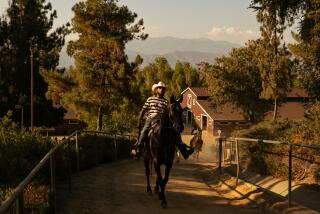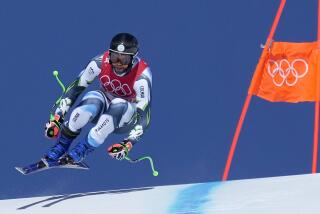Riders Kick Up Their Heels at Competitive Trail Riding
- Share via
INDIAN CAVE STATE PARK, Neb. — Some horse riders like to amble slow enough along country trails to count the leaves on the trees. Diane Colacurci and Yvette Haeberle like to watch them blow by.
For seasoned riders in the sport of competitive trail riding, this is a sweet addiction -- galloping along sometimes treacherous trails at 5 to 6 mph, across some of the most beautiful terrain in the country.
At the Indian Cave Competitive Trail Ride along the Missouri River in Nebraska, Colacurci and Haeberle were part of a volunteer safety patrol.
As the mist began to burn off the river, the first divisions of riders set out onto the trail at 8 a.m. Haeberle, of Kearney, and Colacurci, of Walton, were among the last to start out. Their task was to comb the bluffs above the river for riders in trouble or hopelessly lost off the marked trail.
The job did nothing to quell their enthusiasm for the weekend competition. Like most competitive trail riders, they thrill at the chance to spend about six hours each day of the two-day event on the trail, and camp out.
Over the last decade, competitive trail riding has grown in popularity. Today, about 2,000 to 4,000 riders compete each year in about 80 rides from New England to California and Alaska to the Southwest.
The trails typically are only a few feet wide, and often involve steep up-and-down slopes and a precipitous drop on either side. Add a time limit, obstacles and hidden judges that rate riders’ technique, and you begin to have an idea of what competitive trail riding is all about.
“Lazy people and people who cheat don’t tend to stay in this sport,” said rider Lucy Hirsch of Smithville, Mo., whose horse, Winchester Charm, is in the North American Trail Ride Conference hall of fame. “It’s all knowledge, friendship and bragging rights.”
As a novice competitive trail rider in 1998, Linell Miller learned what it takes to get both horse and rider through the generally two-day-long ride by doing it herself. She got onto her first horse at age 14, but says she’s learned more about horse riding in her six or so years of competitive trail riding than she did during 30 years as a weekend rider.
The sight of the stubbled cowboy of Hollywood movie westerns riding through barren, rugged terrain for days without a single provision makes her laugh. Where’s the water? The food? The feed? “They’re pretty funny now,” she said of those patent inaccuracies.
Miller, from Arvada, Colo., was among about 32 competitors at the Pine Ridge Competitive Trail Ride in August near Chadron, a two-day, 50-mile ride in an area of Nebraska that bares more resemblance to the craggy splendor of South Dakota’s Badlands than the usual gentle, rolling Sandhills of the region. While Miller placed sixth in the competitive pleasure division -- a step above novice -- her horse, Johnny Danger, placed third.
Competitive trail riding was started about 35 years ago in California by a group involved in the Tevis Cup Ride, a legendary test of a rider’s endurance covering 100 miles in one day on one horse. Wanting perhaps not to ride quite so hard and hoping to put more emphasis on horsemanship throughout the ride, the group created competitive trail riding.
Unlike endurance races, riders in competitive trail rides are penalized for traveling through a course too quickly. Instead, the focus is on how the riders and horses get to the finish line. The horse is judged on its condition and trail maneuvering skills throughout the ride. Riders need to show that they have control of their horse and themselves. At points along the trail, each rider is given a timed task to complete, such as backing the horse in a tight circle around a tree. Before the task, a veterinarian might check to make sure that the horse is healthy and has been given enough water during the ride.
Between tasks, a judge camouflaged in the underbrush secretly looks for skills such as whether a rider going up a hill is lazily sitting square on his horse’s back or properly tipped up, putting his weight in the stirrups and holding onto the horse’s mane.
Competitive trail riding falls under the general category of distance riding, which includes mounted orienteering -- navigating the animal through a course using a map and compass -- and endurance riding such as Tevis.
With 700 races per year, endurance is the fastest growing equestrian sport in the nation, said Mike Tomlinson, president of the American Endurance Ride Conference.
“It’s an addiction,” said Tomlinson, who has been involved in endurance riding since 1975. “It is just a good feeling to see an obstacle and be able to say, ‘I overcame it with my horse.’ ”
Although the sport attracts everyone from preteens to riders well into their golden years, it seems to have its strongest appeal for new riders and the baby boomer set, said Cheri Jeffcoat, president of the North American Trail Ride Conference. About 80% of competitive trail riders are women, she said.
Jeffcoat attributes the gender split to what seems to be a greater interest among women to work together with their horses to conquer a trail.
Hirsch said women might also be attracted to the sport because, while demanding a significant amount of strength, it didn’t require the muscles of an equine sport such as rodeo.
New riders enjoy it because it provides a context for them to learn from more seasoned riders how to work with and care for their horse.
At its most basic level, competitive trail riding -- and trail riding in general -- is about learning to build the relationship between rider and horse.
“You’re looking for what people call a Zen ride ... you and your horse are one unit,” said Steve Vogel, trail master of the Pine Ridge Competitive Trail Ride.
He compares a good ride to a good game of golf. “You work towards that perfect game,” said Vogel, whose job is to map out the paths for riders.
But riders stress that competitive trail riding is more than a game.
Trish Cleveland of Wamego, Kan., said that at first she viewed competitive trail riding as something fun to do with the horse her husband gave her as a present. But it soon became a way of life.
” ... People say, ‘Well, who are your friends?’ and all I can picture is people with horses,” Cleveland joked.
She regularly competes with Wayne Tolbert of Knoxville, Tenn., as her partner.
When Tolbert was asked last year to put off his retirement at the company where he worked as an environmental scientist, he handed over his trail riding schedule. He said that was what company managers needed to work around, and they obliged.
He likes that the competition is strictly amateur -- without a big dollar prize or peer pressure to have the most impressive equipment.
He managed to fit in 16 rides around the country last year and hopes to complete 14 by the end of this year.
“I’m not retiring from something,” Tolbert said. “I’m retiring to something.”
More to Read
Sign up for The Wild
We’ll help you find the best places to hike, bike and run, as well as the perfect silent spots for meditation and yoga.
You may occasionally receive promotional content from the Los Angeles Times.






